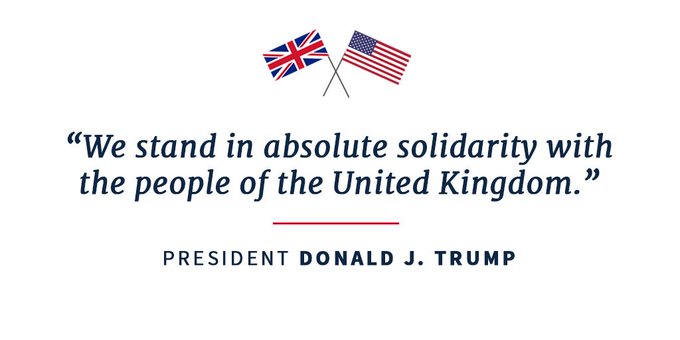The following article by Philip Bump was posted on the Washington Post website September 15, 2017:
British Prime Minister Theresa May said on Sept. 15 that Britain remained on high alert after a bomb exploded on a subway. “I never think it’s helpful for anybody to speculate on what is an ongoing investigation,” May said. (Reuters)
It didn’t take President Trump long to turn Friday morning’s terrorist attack in Britain to his political advantage.
At about 3:20 a.m. Eastern time, a bomb placed in a bucket and hidden on a train in London detonated. By 8 a.m. Eastern, the Metropolitan Police Service had released a statement suggesting that the event was related to terrorism.
Followers of Trump on Twitter, though, would have seen it referred to as terrorism more than an hour earlier. At 6:42 a.m., Trump offered his thoughts.
In addition to claiming that the attack was the work of a terrorist, Trump claimed that the perpetrators were “in the sights of Scotland Yard,” apparently suggesting that they were known to the police. A spokesman for the London police told CNN that this was “pure speculation” — and that such speculation was “unhelpful.”
Trump then went on to make the case for his immigration ban, arguing that it should be “far larger, tougher and more specific” — without going into details about what that additional specificity might entail.
This is not the first time that we’ve seen this pattern from Trump. He frequently is quick to ascribe incidents of violence to terrorism, particularly acts that he believes to have been committed by Islamist terrorists. He is much slower, however, to weigh in on incidents in which Muslims or his political opponents have been targeted.
We’ve collected a number of examples since Trump became the Republican front-runner for his party’s presidential nomination in late 2015.
Terrorists attack a number of sites in Paris including a soccer game, outdoor cafes and a music hall. 130 people are killed.
The incident begins a little after 3 p.m. and isn’t resolved for about three-and-a-half hours. (All times in this article are Eastern.) Shortly before the incident is resolved, Trump tweets about it.
The following morning, he links the attacks to the Islamic State while criticizing then-President Barack Obama.
A married couple attacks a holiday party in California, killing 14 people.
The attack begins shortly before 2 p.m. A few hours later, with details still murky, Trump offers his thoughts.
Thirty minutes later, the police declare the incident to be “domestic terrorism.” Shortly after police kill the terrorists, Trump provides his followers with an update.
In the middle of the attack, he revisits the controversy of the moment.
An EgyptAir flight from Paris bound for Cairo disappears. Trump quickly blames terrorism.
The cause of the plane’s crash has not yet been determined.
Forty-nine people are killed in an late-night mass shooting at the Pulse nightclub by a man claiming allegiance to the Islamic State. Trump links it to terrorism.
Later, he adds an additional thought.
At a bar in Kansas, a man shoots two Indian men after telling them to “get out of my country” and addressing them with racial slurs indicating that the shooter thought the men were Muslim.
Trump is called on to comment on the attack. He does so several days later during a speech to Congress.
A bomb exploded outside of an Ariana Grande concert while Trump was on his first international trip as president.
The following morning he offers the nation’s support for Britain.
Later, he ties the attack to the broader battle against terrorism and the need “to live in safety and in peace.”
Two men confront a man on a train in Portland, Ore., who is verbally abusing two woman who appear to be Muslim. The abusive man pulls out a knife and stabs his confronters, killing both.
Trump is again called on to make a statement about the incident. He does so two days later from his @POTUS Twitter account.
An attacker drives a van into a crowd of people on London Bridge. He and two other men then embark on a brief stabbing charge before being killed by police.
Trump quickly retweets a Drudge Report tweet tying the incident to terrorism. He then tweets about the travel ban.
About 10 minutes later, the London police confirm publicly that the incident is terrorism.
During protests in Charlottesville, organized by white nationalists and supporters of Nazism, a counterprotester, Heather Heyer, is killed when a man linked to a racist group drives into a crowd with his car.
That day, Trump blames the violence of the day on “many sides” having behaved improperly. After that response is criticized, he issues a new statement, praising Heyer.
At a news conference at Trump Tower the following day, the president explains why he didn’t immediately criticize the racism that led to Heyer’s death.
“I didn’t wait long. I wanted to make sure, unlike most politicians, that what I said was correct, not make a quick statement,” Trump said. “The statement I made on Saturday, the first statement, was a fine statement. But you don’t make statements that direct unless you know the facts. It takes a little while to get the facts. You still don’t know the facts. And it’s a very, very important process to me. And it’s a very important statement.”
“I don’t want to go quickly and just make a statement for the sake of making a political statement,” he added. “I want to know the facts.”












